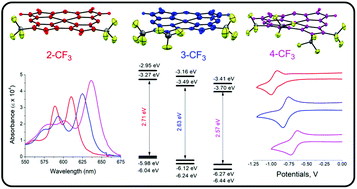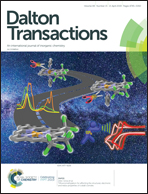Trifluoromethylation for affecting the structural, electronic and redox properties of cobalt corroles†
Abstract
Cobalt corroles excel as catalysts in the two most clean-energy-relevant processes, the electrochemical oxygen reduction reaction (ORR) and the hydrogen evolution reaction (HER). Common to both is the need to replace platinum by earth abundant metal ions and the desire to positively shift the redox potentials of the catalysts. The main aim of this study was to prepare cobalt corroles whose macrocyclic skeleton contains trifluoromethyl groups, since they are purely electron withdrawing with no π-back donation capability. New synthetic methodologies were developed for gaining access to a series of cobalt(III) corroles with two, three, and four CF3 groups and all of them were fully characterized for determining the effect of the CF3 groups on the structural parameters, electronic structures and redox processes. Our most novel findings are the ability to control the number and positioning of the CF3 groups, the macrocycle deformation and the quite dramatic changes in the electronic spectra induced thereby, the isolation of 4-coordinate cobalt(III) corroles and the paramagnetic NMR spectra of these intermediate-spin complexes, and the 180 mV/CF3 shift of redox potentials in the direction desired for the utility of the complexes as electrocatalysts.



 Please wait while we load your content...
Please wait while we load your content...